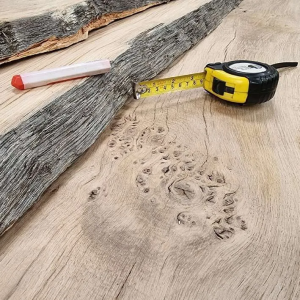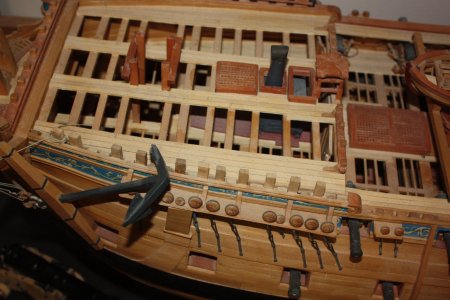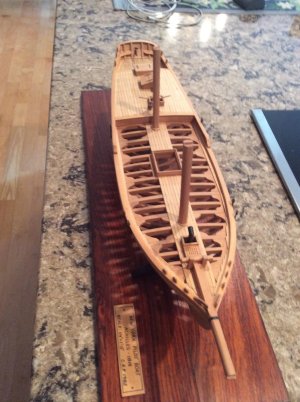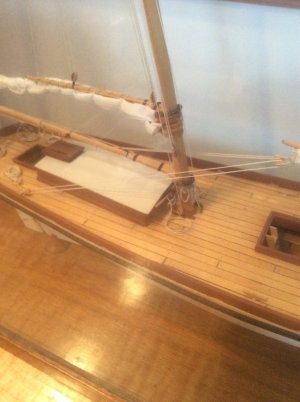-

Win a Free Custom Engraved Brass Coin!!!
As a way to introduce our brass coins to the community, we will raffle off a free coin during the month of August. Follow link ABOVE for instructions for entering.
You are using an out of date browser. It may not display this or other websites correctly.
You should upgrade or use an alternative browser.
You should upgrade or use an alternative browser.
I did some searching on this and was surprised that the use of coated canvas was used on upper decks starting the early 19th century. For me, that is not a pretty thing. Some thoughts regarding trennals........ they were not generally used on decks. Wrought iron spikes or dumps were used then covered with a diamond shaped or round wooden disk. For our purposes, a wooden trennal does give the appearance of the wooden disk cover. When the wood of the decks was holystoned, the wooden disks were subtly visible, if at all. On scales smaller than 1:48 leaving out the wooden covers or trennals is often a good idea.
Allan
Allan
- Joined
- Oct 2, 2025
- Messages
- 50
- Points
- 58

About decks :
holystoning involved something like a curling stone attached to ropes and pulled back and forth over a layer of sand. The deck was actually sanded. What species of wood that was used for decking will turn white after sanding?
Sun bleached wood - at least Maple, is silver/grey. Do not know what sun bleached White Oak or Yellow Pine looks like.
I see that using N.A. snow white marquetry Holly for decking on a model does not represent anything real.
The old molder books that suggest using Holly were by European authors? European Holly is yellow, not white?
holystoning involved something like a curling stone attached to ropes and pulled back and forth over a layer of sand. The deck was actually sanded. What species of wood that was used for decking will turn white after sanding?
Sun bleached wood - at least Maple, is silver/grey. Do not know what sun bleached White Oak or Yellow Pine looks like.
I see that using N.A. snow white marquetry Holly for decking on a model does not represent anything real.
The old molder books that suggest using Holly were by European authors? European Holly is yellow, not white?
I think other than the platforms and orlop decks were primarily English oak and elm.
English oak

The below model is made with castello frames and planking on the hull, North American holly on the decks and Swiss pear on the deck furniture. My color vision is not the best, but I do not think the color of holly is so white as to be unrealistic. Just my opinion.

English oak

The below model is made with castello frames and planking on the hull, North American holly on the decks and Swiss pear on the deck furniture. My color vision is not the best, but I do not think the color of holly is so white as to be unrealistic. Just my opinion.

- Joined
- Oct 2, 2025
- Messages
- 50
- Points
- 58

The light - camera - tech - the photo's Holly has a yellow cast - probably a European variety - or similar to my cousin's Holly.
It is within spec. I can get Hard Maple for ~$7 a BF. A gym floor shows the color.
The near pure white / Ivory American commercial Holly - costs ~$35+ a BF is a bit more stark.
A dream of mine: find a large supply of yellow or Blue Mold infected Holly that the owner considers to be trash and get a deal.
All Blue Mold does is change the color (grey mostly but also robin's egg blue)- the quality of the wood is unaffected. This type of Holly is near perfect for a ship model.
It is within spec. I can get Hard Maple for ~$7 a BF. A gym floor shows the color.
The near pure white / Ivory American commercial Holly - costs ~$35+ a BF is a bit more stark.
A dream of mine: find a large supply of yellow or Blue Mold infected Holly that the owner considers to be trash and get a deal.
All Blue Mold does is change the color (grey mostly but also robin's egg blue)- the quality of the wood is unaffected. This type of Holly is near perfect for a ship model.
- Joined
- Jun 29, 2024
- Messages
- 1,294
- Points
- 393

Photo below: The Holly decking was cut from a tree in Ohio. Framing is native pear also cut locally. Like Dean’s model the Holly is off white. The deck on the second model is Basswood, also cut in Ohio but not by me. Slightly more yellow than the Holly.
Believe it or not there are cheaper, softer, and whiter woods than Basswood; Aspen aka Poplar in some regions and Cottonwood. I suspect that kit builders may be used to working with woods called basswood that are actually one of the above.


Believe it or not there are cheaper, softer, and whiter woods than Basswood; Aspen aka Poplar in some regions and Cottonwood. I suspect that kit builders may be used to working with woods called basswood that are actually one of the above.


I recall seeing the canvas decks but they had a layer of wood over the sealed canvas. On some cabin tops to without a layer of wood on top. Just sealed and painted. Good way to waterproof something without adding a lot of weight to it. Fiberglass over wood is about the same thing but FG over wood is not good in my opinion.
- Joined
- Jun 29, 2024
- Messages
- 1,294
- Points
- 393

I have posted elsewhere about watching my father build an H-23 L. Francis Herreshoff sailboat. This was before use and availability of fiberglass so the boat had a canvas covered deck. I dimly remember him laying it. I believe that it was rolled over a coat of wet paint. Once this had dried the canvas was painted.
Roger
Roger



